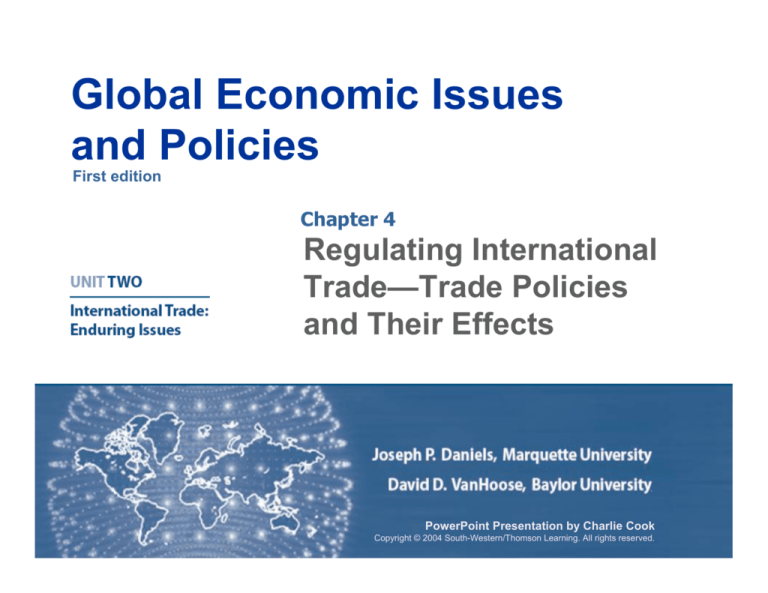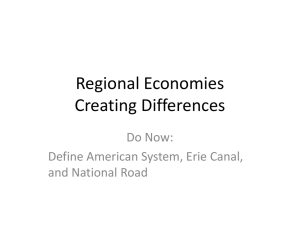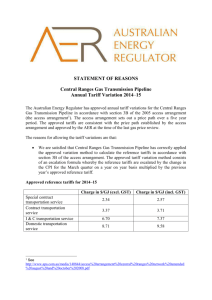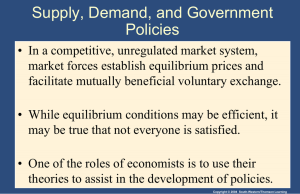
Global Economic Issues
and Policies
First edition
Chapter 4
Regulating International
Trade—Trade Policies
and Their Effects
PowerPoint Presentation by Charlie Cook
Copyright © 2004 South-Western/Thomson Learning. All rights reserved.
1. How do taxes affect the market price, and what
are the redistributive effects of taxes?
2. What are tariffs, and what are the economic
effects of tariff barriers?
3. What are quotas, and how do they represent a
direct approach to restricting trade?
4. What are voluntary export restraints?
Copyright © 2004 South-Western/Thomson Learning. All rights reserved.
4–2
5. What are the effects of export subsidies, and
how do policymakers typically react to export
promotion policies?
6. What are the advantages and disadvantages of
trade barriers?
Copyright © 2004 South-Western/Thomson Learning. All rights reserved.
4–3
Taxes and Their Direct Effect on Price
• Tariff
¾ A tax on imported goods and services.
• Forward Shifted Taxes
¾ The portion of a tax that consumers pay in the form of
a higher price per unit.
• Backward Shifted Taxes
¾ The amount of a tax that producers pay in the form of
lower revenue per unit.
• Tax Revenue
¾ The amount of taxes that are forward shifted and the
amount of taxes that are backward shifted.
Copyright © 2004 South-Western/Thomson Learning. All rights reserved.
4–4
Table 4-1
The Supply Schedule of a Running Shoe Manufacturer
Copyright © 2004 South-Western/Thomson Learning. All rights reserved.
4–5
Table 4-2
The After-Tax Supply Schedule of a Running Shoe Manufacturer
Copyright © 2004 South-Western/Thomson Learning. All rights reserved.
4–6
Figure 4-1
The Effects of a Tax
Copyright © 2004 South-Western/Thomson Learning. All rights reserved.
4–7
Types of Tariffs
• Specific Tariff
¾ A tariff specified as an amount of money per unit of
the good sold.
• Ad Valorem Tariff
¾ A tariff calculated as a percentage of the value of the
good or service.
• Combination Tariff
¾ A tariff that combines an ad valorem tariff and a
specific tariff.
Copyright © 2004 South-Western/Thomson Learning. All rights reserved.
4–8
Table 4-3
Selected U.S.
Tariff Rates
Source: Harmonized Tariff Schedule of the United States http://dataweb.usitc.gov/scripts.tariff.asp
Copyright © 2004 South-Western/Thomson Learning. All rights reserved.
4–9
Benefits and Weaknesses of Tariffs
• Specific Tariffs
• Ad Valorem Tariffs
¾Advantage
Easy to calculate.
¾Disadvantage
Does not adjust to
price changes.
Copyright © 2004 South-Western/Thomson Learning. All rights reserved.
¾Advantage
Always amounts to
the same percentage
of the value of the
good or service.
¾Disadvantage
More difficult to
calculate.
4–10
Effects Of A Tariff In A Small-Country
Setting
• Small Country
¾ A country so small its
consumption and
production decisions do
not affect the
international price, so
that its residents take
the international price
as a given.
Copyright © 2004 South-Western/Thomson Learning. All rights reserved.
4–11
Effects Of A Tariff In A Small-Country
Setting (cont’d)
• The Price Effect of a Tariff in a Small-Country
Setting
¾ The domestic price that consumers must pay equals
the global price plus the amount of the tariff.
¾ The domestic price paid by domestic consumers and
the revenue received by domestic producers rises by
the full amount of a tariff.
¾ The quantity demanded declines and quantity
supplied by domestic producers increases, the tariff
causes the quantity of imports to shrink.
Copyright © 2004 South-Western/Thomson Learning. All rights reserved.
4–12
Effects Of A Tariff In A Small-Country
Setting (cont’d)
• Forward and Backward Shifting of the Tariff in
a Small-Country Setting
¾ The revenue per unit that domestic producers
receive increases, so none of the tariff is backward
shifted to domestic producers.
¾ The revenue per unit that foreign producers receive
after paying the tariff remains the same, so none of
the tariff is backward shifted to foreign producers.
¾ Domestic consumers pay the entire (forwardshifted) tariff in the form of higher prices of foreign
products they purchase.
Copyright © 2004 South-Western/Thomson Learning. All rights reserved.
4–13
Effects Of A Tariff In A Small-Country
Setting (cont’d)
• Redistributive Effects of a Tariff in a SmallCountry Setting
¾ Deadweight loss
A
loss of consumer or producer surplus that is not
transferred to any other party and that represents a
decline in economic efficiency.
¾ Economic efficiency
A
condition when scarce resources are allocated in a
most productive, least-cost pattern.
Copyright © 2004 South-Western/Thomson Learning. All rights reserved.
4–14
Figure 4-2
The Small-Country Tariff
Copyright © 2004 South-Western/Thomson Learning. All rights reserved.
4–15
Effects Of A Tariff In A Large-Country
Setting
• Large Country
¾ A large country’s market share is sufficiently large
that the production and consumption decisions of its
residents affect the global prices of goods and
services.
• The Price Effect of a Tariff in a Large-Country
Setting
¾ Imposing a tariff causes domestic prices to rise, which
reduces the domestic quantity demanded and
increases the domestic quantity supplied, thereby
reducing imports.
Copyright © 2004 South-Western/Thomson Learning. All rights reserved.
4–16
Effects Of A Tariff In A Large-Country
Setting (cont’d)
• Forward and Backward Shifting of a Tariff in a
Large-Country Setting
¾ Part, but not all, of a tariff is forward shifted to
domestic consumers.
¾ The remaining portion of the tariff is backward
shifted to the foreign producers.
• Beggar-Thy-Neighbor Policy
¾ A policy action that benefits one nation’s economy
but worsens economic performance in another
nation.
Copyright © 2004 South-Western/Thomson Learning. All rights reserved.
4–17
Effects Of A Tariff In A Large-Country
Setting (cont’d)
• Redistributive Effects of a Tariff in a LargeCountry Setting
¾ The increase in the domestic price generates a loss
of consumer surplus.
Higher
domestic producer revenues and surplus.
Tariff revenues gained by the domestic government
Deadweight losses arise from the same types of
inefficiencies created by a tariff in a small-country
setting.
Copyright © 2004 South-Western/Thomson Learning. All rights reserved.
4–18
Figure 4-3
The Effects of a Tariff in a Large-County Setting
Copyright © 2004 South-Western/Thomson Learning. All rights reserved.
4–19
The Economic Effects of Tariff Barriers
• Small-Country Setting
¾ Tariffs do not affect global prices.
¾ The entire amount of the tariff is forward shifted to
domestic consumers.
• Large-Country Setting
¾ Tariffs cause global prices to decline.
¾ Part of the tariff is forward shifted to domestic
consumers and part is backward shifted to foreign
producers.
• A tariff always results in deadweight losses for
both small and large countries.
Copyright © 2004 South-Western/Thomson Learning. All rights reserved.
4–20
Quotas: A Direct Approach to Restricting
Trade
• Import Quota
¾ A policy that restricts the quantity of imports.
• Absolute Quota
¾ A quantitative restriction that limits the amount of a
product that can enter a country during a specified
time period.
• Tariff-rate Quota
¾ A quota that allows a specified quantity of a good to
enter the country at a reduced tariff rate. Any
quantity above that amount is subject to a higher
tariff rate.
Copyright © 2004 South-Western/Thomson Learning. All rights reserved.
4–21
Table 4-4
Selected U.S. Import Quotas
Source:The U.S. Office of Textiles and Apparel, http://www.otexa.ita.doc.gov.
Copyright © 2004 South-Western/Thomson Learning. All rights reserved.
4–22
Economic Effects Of A Quota
• Direct Effects on the Quantity of Imports and
Indirect Effects on the Domestic Price
¾ By restricting imports, a quota increases the domestic
price and expands the market share of domestic
producers.
¾ The increase in price generates a rise in domestic
quantity supplied and a decline in domestic quantity
demanded.
Copyright © 2004 South-Western/Thomson Learning. All rights reserved.
4–23
Figure -4
The Effects of an Import Quota
Copyright © 2004 South-Western/Thomson Learning. All rights reserved.
4–24
Economic Effects Of A Quota (cont’d)
• Redistributive Effects of a Quota
¾ Domestic prices rise and consumer surplus declines.
¾ Part of consumer surplus is transferred to domestic
producers in the form of higher revenues.
¾ Part of consumer surplus is transferred to the foreign
producers who fill the quota and receive a higher
price per unit.
¾ Deadweight losses occur as domestic producers shift
scarce resources away from more efficient industries
into quota-protected industries and consumers
substitute away from quota-protected goods to less
desirable substitutes.
Copyright © 2004 South-Western/Thomson Learning. All rights reserved.
4–25
Table 4-5
The Costs of Protection
Source: Data from Shuguang, Yansheng and Zhongxin (1998), Sazanami, Urato and Hiroki (1995), Kim (1996), Hufbauer and Elliot (1994).
Copyright © 2004 South-Western/Thomson Learning. All rights reserved.
4–26
Quota Rent
• Quota Rent
¾ A portion of the loss of consumer surplus caused by
an import quota that is transferred to the foreign
supplier as additional profits.
• Allocating the Quota Rent
¾ Governments determine quota rents by:
Allowing
quotas to be filled on a first-come basis.
Allocating quota rents to allow quotas to be filled by the
firms of nations receiving preferential treatment.
Charging for licenses that authorize foreign firms to fill
quotas.
Copyright © 2004 South-Western/Thomson Learning. All rights reserved.
4–27
Voluntary Export Restraints
• Voluntary Export Restraint (VER)
¾ An agreement between policymakers and producers
in two nations to restrict the exports of a good from
one nation to the other.
• The Appeal of VERs
¾ Establishes an informal quota on exports—exporters
prefer to restrict their activities instead of submitting to
the whims of foreign policymakers.
¾ VERs are not under the jurisdiction of regulatory
bodies that monitor regional and multilateral trade
agreements.
Copyright © 2004 South-Western/Thomson Learning. All rights reserved.
4–28
Voluntary Export Restraints (cont’d)
• VERs and Prices
¾ VERs cause domestic prices to rise and have indirect
effects on imports from producers in another nation.
¾ VERs can have significant effects on the type of
products chosen for exportation.
• Effects of VERs
¾ Creates a loss of domestic consumer surplus:
Part
of surplus is transferred to domestic producers.
Deadweight losses account for a part of the loss.
Rents accrue to foreign producers agreeing to the VER.
Copyright © 2004 South-Western/Thomson Learning. All rights reserved.
4–29
Export Subsidies and Countervailing Duties
• Export Subsidy
¾ A payment by a government to a domestic firm for
exporting its goods or services.
• Effects Of An Export Subsidy
¾ Subsidized exports cause global market price
declines.
¾ Foreign subsidies generate increases in the amount
of imports by domestic residents.
¾ Subsidization causes domestic price declines,
domestic consumer surplus increases, and reduced
domestic producer surpluses.
Copyright © 2004 South-Western/Thomson Learning. All rights reserved.
4–30
Dumping
• Dumping
¾ A situation in which a firm sells its output to foreign
consumers at a price that is less than what the firm
charges its domestic consumers, or when a foreign
firm prices its exports below their cost of product.
• Countervailing Duty (CVD)
¾ A tax on imported goods and services designed to
offset the domestic price effect of foreign export
policies.
Copyright © 2004 South-Western/Thomson Learning. All rights reserved.
4–31
Trade Barriers and Their Costs
• First-best Trade Policy
¾ A trade policy that deals directly with the problem that
policymakers seek to remedy.
• Second-best Trade Policy
¾ A trade policy that deals indirectly with a problem that
policymakers seek to remedy.
Copyright © 2004 South-Western/Thomson Learning. All rights reserved.
4–32
Questions and Problems - 5)
Copyright © 2004 South-Western/Thomson Learning. All rights reserved.
4–33








